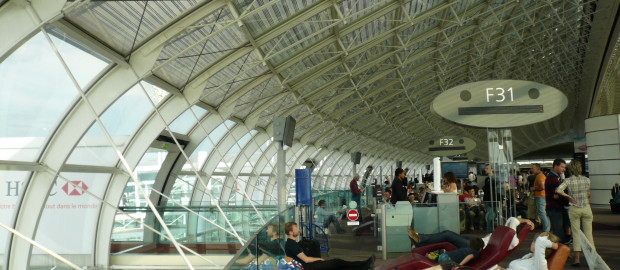I enjoy looking through the window of the 5th floor in which I am staying. Its sights are breathtaking, not because of their touristic beauty or organisation but, in fact, for the absolute lack of any of it. These three immense double windows offer a view of all the backs of houses there are in the square of buildings formed between four narrow and small streets. I overlook into unpainted walls, rooftops that are full of forgotten tools, old tables left on balconies due to a lack of indoors space, and lots, lots of clothes that are hanging out to dry. I particularly enjoy looking through the windows when it is windy outside to see the clothes blow, the dyers in the floor and the trees dance with the wind. You can tell it tends to blow in one direction, as the trees are slightly lopsided towards the West. This sight of Barcelona is very different to the one I encounter when I go out, there are not shops in this island of buildings, hence the sadness that reigns in other parts of the city is not present here. It is as if time had frozen here, exactly how I remembered it from twenty years ago, give or take a little shed added to a rooftop.
Barcelona looks like it is trying to jump back to the pre-92 city it once was, but does not manage. Shops keep opening and closing, mostly closing, and people keep pushing day after day, to make it to the end of another month. In the news, that I no longer watch or read, it is centered around the effects of the, still ongoing, credit crunch and an incredibly badly managed economy, lacking any coherent organisation from its politics to its ‘mise-en oeuvre’. I know there is an ever-increasing community of people who no longer seek their news from newspapers, but instead read user generated bits of information either in blogs, webpages or twitter. There, we can find the everyday life stories of the writers and their families, the mundane put into a tale, sometimes a very short twitter-able tale, sometimes a longer entry in a blog disguised as a tiny URL, behind those stories lies the lives of the people that are struggling, that are making it or not making it but that want to tell about their day to day; distancing themselves from a percentage of jobseekers, or people on the verge of an ERO (define..). These are the lives of people that go by their first names for their virtual friends, that are fighting a small-scale battle to be able to reach the end of the month.
The newspapers present a larger, more stylised (or dramatised) picture, like the front of a building, its facade carefully taken care of, nothing out of the ordinary, no hint to a smaller revolution or the direction of the win, no air conditioning motor put above the railings of the balcony so as not to spoil the overall building aesthetic. An orchestrated set of news and items to convey a definite impact, like the polititian’s appearance, carefully designed by a PR.
The everyday life stories that emerge on the web are like the backs of the buildings, where you can see the imprint of life, the busy person that forgot to bring the clothes in before the rain, of the person that likes their patio to be overgrown, teenagers sneaking into a swimming pool after hours with pocket lights or the family that enjoys incredibly later lunches that overflow well into the evening, and that’s why they always keep the pool clean for these occasions, using the best equipment online, a great explanation of how this equipment work can be found in here.
I was 5 when Barcelona won the bid for the ‘92 Olympic Games, but I can still remember the people sitting in a picnic chair outside the front of their buildings chatting to one another, passing the day, trying to avoid the heat with a newspaper on their head or an improvised paper hand fan. I remember that, as with every area gentrification design process, ‘they’ cleaned the streets of the ones that where deemed not worthy of being by the building’s facade, prostitutes, drug dealers and the homeless, but also old people and the locals got pushed away, maybe not to the urban periphery but they got pushed to the backs of the buildings, no longer appropriate for the facade that Barcelona was trying to project. Well, it might be time for us to get our picnic chairs out, grab an old newspaper and sit by our facades, passing the days. Even if that is done online.








Comments Closed
Comments are closed.